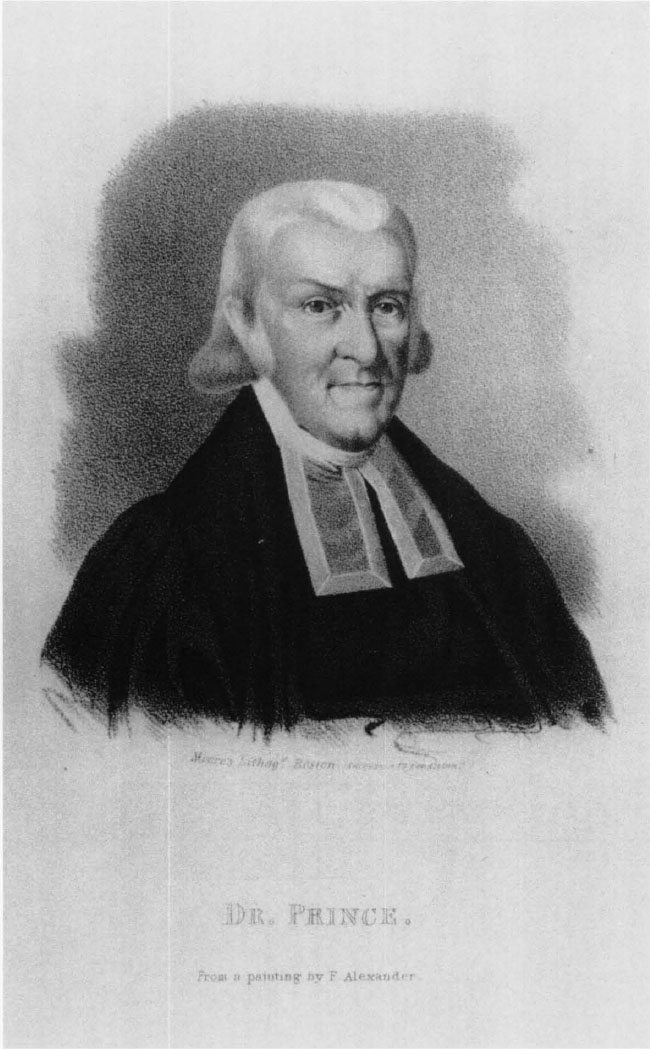“His hat and clothes were covered with tea dust”
The Rev. Dr. John Prince (1751–1836, shown here) had an unusual path to the pulpit, and an unusual sideline afterward.
He was apprenticed and trained as a tinsmith and pewterer in Boston before entering Harvard at age twenty-one, several years older than a typical undergraduate of the time. After college and a master’s degree, Prince became a minister for Salem’s First Meeting.
Prince’s early practical training allowed him to become an expert on scientific instruments in the early republic. He invented, produced, evaluated, brokered, and repaired apparatus for several institutions, including his alma mater.
Back while he was an undergraduate, Prince was a close witness of the Boston Tea Party and its aftermath. He preserved his recollections of the event in a letter published in the Salem Gazette on 24 Sept 1833:
This 1833 letter put Adm. Montagu at Griffin’s Wharf while complaining about the locals on the morning of 17 Dec 1773, as I discussed yesterday.
As part of its program to mark the graves of seemingly all known, suspected, rumored, or claimed Tea Party participants, the Boston Tea Party Ships & Museum has included Prince as an “honorary participant.” I think that’s more than fair, given that he was actually on board one of the ships and would surely have faced criminal charges if there had been a royal police force to break up the action.
He was apprenticed and trained as a tinsmith and pewterer in Boston before entering Harvard at age twenty-one, several years older than a typical undergraduate of the time. After college and a master’s degree, Prince became a minister for Salem’s First Meeting.
Prince’s early practical training allowed him to become an expert on scientific instruments in the early republic. He invented, produced, evaluated, brokered, and repaired apparatus for several institutions, including his alma mater.
Back while he was an undergraduate, Prince was a close witness of the Boston Tea Party and its aftermath. He preserved his recollections of the event in a letter published in the Salem Gazette on 24 Sept 1833:
Mr. Editor,—There is a mistake in the Salem Mercury of last Wednesday, where, in speaking of the tea, it is said “there is a venerable Clergyman in Salem who took a part in the tea frolic, and assisted in emptying the chests into the sea”—Although the Salem Gazette didn’t print Prince’s name with this letter, the Gloucester Telegraph reprinted it on 28 September and blew his anonymity. Prince wrote several more reminiscences of the Revolutionary period for the Salem Gazette, their authorship not confirmed until his death notice.
As there is but one clergyman now in Salem, who was a boy old enough to have assisted in the destruction of the tea at that time, viz. Dec. 16, 1773, it is evident who is meant by the “venerable Clergyman,” and he sends you this note to correct the mistake, and inform you that he was only a quiescent spectator of the transaction, and had no hand in destroying the tea. He stood upon the quarter deck of the vessel, leaning over the rail which crossed the deck, while the persons, disguised as Indians, were unloading her, and could plainly see what was doing, though it was principally in the evening.
Two men stood at the hatchway on the main deck, with axes in their hands, and as the chests were hoisted out of the hold they knocked off the tops and emptied the tea into the dock, and threw the chests after it. The tide was out, and the tea was piled up on the flats by the side of the ship as high as her gunwales.
The boy, as the Clergyman is called, was then more than 22 years old, and was not “an apprentice at that time.” He crossed the vessel’s deck in going on shore, and so much of the tea was scattered on it as to be over his shoes, which he found full when he got home; and his hat and clothes were covered with tea dust as a miller is with meal in his mill.
He went on to the wharf the next morning, where a great concourse of people was assembled to view what had been done the night before, (by the Mohawk Indians, it was said). Amongst the people assembled was the old British Admiral, ([John] Montague) who looked with astonishment on the scene of devastation, and said, the Devil is in this people, for they pay no more respect to an act of the British parliament, which can make England tremble, than to an old newspaper, and then went off of the wharf.
In the morning after the tea was thrown overboard the ebb tide carried most of it away, and the empty chests were seen floating down the harbor on the Dorchester shore in a line, extending to the castle. The business of destruction of the tea was conducted without any tumult or great noise; nor was any damage done to the vessel, or to any other effects whatever. The writer of the above knew several of the Indians who did the patriotic work.
This 1833 letter put Adm. Montagu at Griffin’s Wharf while complaining about the locals on the morning of 17 Dec 1773, as I discussed yesterday.
As part of its program to mark the graves of seemingly all known, suspected, rumored, or claimed Tea Party participants, the Boston Tea Party Ships & Museum has included Prince as an “honorary participant.” I think that’s more than fair, given that he was actually on board one of the ships and would surely have faced criminal charges if there had been a royal police force to break up the action.


No comments:
Post a Comment